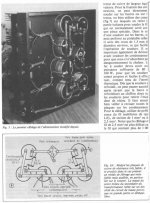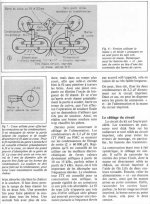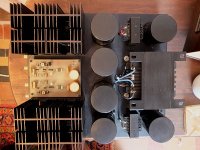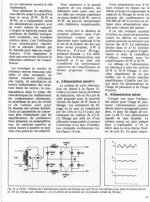Hello,
The only caps i bought on ebay were Russian paper in oil and some Siemens MKV in GErmany.
I would get the caps at companies like Digikey, Mouser
68000 µF is a good value to use as the first cap then a LL2733 and then a 220000µF.
The specs of the caps used in the 30 watt Hiraga can be found in number 31 of the French audiophile magazine. 60A continous current delivery at 40 degrees surrounding temperature. Serie resistance 1,5 milliohm at 100 hertz.
In the pdf it says you cannot mount them upside down but the hiraga amps did but they used another brand! Long time ago i did have some mallory caps were the upper part of the housing was empty so there the cap itself could slide down when mounted upside.
If the 220000 is to high you could use a pair of 100000 which will give a bigger current delivery.
In one of my post i did mention how to interconnect the caps but it is in french. you can find it online.
file:///C:/l'audiophile%20tijdschriften%20van%20cdr/FICHIERS/15/CLASSEA/CLASSEA.html
greetings, Eduard
The only caps i bought on ebay were Russian paper in oil and some Siemens MKV in GErmany.
I would get the caps at companies like Digikey, Mouser
68000 µF is a good value to use as the first cap then a LL2733 and then a 220000µF.
The specs of the caps used in the 30 watt Hiraga can be found in number 31 of the French audiophile magazine. 60A continous current delivery at 40 degrees surrounding temperature. Serie resistance 1,5 milliohm at 100 hertz.
In the pdf it says you cannot mount them upside down but the hiraga amps did but they used another brand! Long time ago i did have some mallory caps were the upper part of the housing was empty so there the cap itself could slide down when mounted upside.
If the 220000 is to high you could use a pair of 100000 which will give a bigger current delivery.
In one of my post i did mention how to interconnect the caps but it is in french. you can find it online.
file:///C:/l'audiophile%20tijdschriften%20van%20cdr/FICHIERS/15/CLASSEA/CLASSEA.html
greetings, Eduard
Hi Eduard
I looked into your threads about using the chokes, wow goes back to the year 2008!
I think i will take this route, it adds to the budget but seems logical to use them.
Resonant-choke Power Supply
I tried looking for the magazine number 31 but hard to find 🙁 perhaps you can scan it and post it?
The link below in your reply does not seem to work.
I have asked a few companies to give me quotes on transformers, both R Core type and EI type. They ask me lots of questions in regards to how much current and amps i need etc, this i wasn't sure of.
It would be helpful if you had a schematic of the power design using chokes. Can they handle the demands of the amplifier? You seem to have a great deal of experience with using chokes on the Hiraga.
I am sourcing some reputable Capacitors, yes i may use mouser to buy them.
Thank you for your continued advice and help.
I looked into your threads about using the chokes, wow goes back to the year 2008!
I think i will take this route, it adds to the budget but seems logical to use them.
Resonant-choke Power Supply
I tried looking for the magazine number 31 but hard to find 🙁 perhaps you can scan it and post it?
The link below in your reply does not seem to work.
I have asked a few companies to give me quotes on transformers, both R Core type and EI type. They ask me lots of questions in regards to how much current and amps i need etc, this i wasn't sure of.
It would be helpful if you had a schematic of the power design using chokes. Can they handle the demands of the amplifier? You seem to have a great deal of experience with using chokes on the Hiraga.
I am sourcing some reputable Capacitors, yes i may use mouser to buy them.
Thank you for your continued advice and help.
Hello,
The only caps i bought on ebay were Russian paper in oil and some Siemens MKV in GErmany.
I would get the caps at companies like Digikey, Mouser
68000 µF is a good value to use as the first cap then a LL2733 and then a 220000µF.
The specs of the caps used in the 30 watt Hiraga can be found in number 31 of the French audiophile magazine. 60A continous current delivery at 40 degrees surrounding temperature. Serie resistance 1,5 milliohm at 100 hertz.
In the pdf it says you cannot mount them upside down but the hiraga amps did but they used another brand! Long time ago i did have some mallory caps were the upper part of the housing was empty so there the cap itself could slide down when mounted upside.
If the 220000 is to high you could use a pair of 100000 which will give a bigger current delivery.
In one of my post i did mention how to interconnect the caps but it is in french. you can find it online.
file:///C:/l'audiophile%20tijdschriften%20van%20cdr/FICHIERS/15/CLASSEA/CLASSEA.html
greetings, Eduard
Thanks Pano, you will be glad to know i will be spending time planning the power supply and keeping it traditional. I likes eduard advice on using chokes.
Thanks for the link on the capacitors!
Thanks for the link on the capacitors!
Well here in the USA Digikey has some nice 68000uF screw terminal caps made by TDK. They are low inductance and fairly low ESR.
https://en.tdk.eu/inf/20/30/db/aec/B41456_B41458.pdf
About $30 each for the 40V version.
They also carry the 220000uF for $81 each. Still very low ESR about 5mOhm. You'd need only 1 per side after filtering.
hahaha yes we are having a big party! Nice work! I am also planning on building mono blocks!
woohoo.. looks like Hiraga 30W builders are having a party here..
what i really like is each one of us have followed different approach towards building this monster!
mine is a monoblock build..
An externally hosted image should be here but it was not working when we last tested it.
An externally hosted image should be here but it was not working when we last tested it.
Hello,
The drawing of the copper bar underneath the photo was later changed into the other drawing. The second one gives less noise just because the cable to the circuits departs from the centre of the bar and not from thje end where the cap is connected.
The picture is another design with the same chokes i used for my 30 watt.
In the small graphic near the power supply circuit drawing you can see the ripple without Rc, with RC and with LC.
If you get an R core just also ask for a static screen and multiple secundairy taps so you can easiliy adjust the output voltage to the circuit.
You can copy the design from the power supply in the attachment. Using other transformer 68000µF LL2733 and a pair of 100000µF or 220000µF caps.
I am not sure if double mono would be better? You will need to spend double the money. I think better get one 500VA R core and use more caps after the choke than spending 200 euros extra on chokes and an extra transformer.
Greetings, Eduard
The drawing of the copper bar underneath the photo was later changed into the other drawing. The second one gives less noise just because the cable to the circuits departs from the centre of the bar and not from thje end where the cap is connected.
The picture is another design with the same chokes i used for my 30 watt.
In the small graphic near the power supply circuit drawing you can see the ripple without Rc, with RC and with LC.
If you get an R core just also ask for a static screen and multiple secundairy taps so you can easiliy adjust the output voltage to the circuit.
You can copy the design from the power supply in the attachment. Using other transformer 68000µF LL2733 and a pair of 100000µF or 220000µF caps.
I am not sure if double mono would be better? You will need to spend double the money. I think better get one 500VA R core and use more caps after the choke than spending 200 euros extra on chokes and an extra transformer.
Greetings, Eduard
Attachments
In talking about the power supply, the article mentions that DC protection on the outputs is a good idea. Yes, yes it is. You can guess how I know this. 😱
I can't help feeling all the capacitance in the PSU is a bit OTT. What's wrong with regulation instead?
In talking about the power supply, the article mentions that DC protection on the outputs is a good idea. Yes, yes it is. You can guess how I know this. 😱
Hello,
Sure i did use one. If you are using a cheap speaker still available you could take the risk lol. But many people in france at that time were using expensive Altec, Focal, Onken, Tad drivers so better have them well protected.
Greetings, Eduard
Hello,
Sure i did use one. If you are using a cheap speaker still available you could take the risk lol. But many people in france at that time were using expensive Altec, Focal, Onken, Tad drivers so better have them well protected.
Greetings, Eduard
I blowed and almost melted the coil from one speaker when i was doing some tests (lucky for me that i had some spare coils at disposal and those speakers where cheap).. I used slow blow just for the trafo at the time but i had forgotten that the caps remain charged after the trafo fuse blows so it blowd the outputs too.

Now i use fast blow fuses on trafos, input psu, output psu and speaker output with succes. They really helped me when i burned out a rubanoid coil.😎
Maybe after a rebuild i will make a protection board, but now i dont have enought space in the enclosure.
Ps: Eduard i know that article, and its from the Kaneda amplifier.
I can't help feeling all the capacitance in the PSU is a bit OTT. What's wrong with regulation instead?
Hi Scott,
I, like you was wondering that. But after reading Hiraga's articles i have seen why.
Here you have just a couple of articles about the PSU used for the KANEDA preamplifier wich was one of the reference of the preamplifiers those days, had poor psrr but sounded extraordinary (as allot of good amps and preamps novadays):
Influence des circuits d'alimentation, le cas du prampli Kanda.
L'influence des circuits d'alimentation
L'influence des circuits d'alimentation -3- Amlioration d'une alimentation non rgule
alim
And here you have an extensive study on they're bench and test psu used for all they amplifiers and preamplifiers for the input (super classe a , le monstre, etc):
Vielles recettes ou nouvelle cuisine pour nos alimentations (Hphatos)
Vielles recettes ou nouvelle cuisine pour nos alim -2- exprimentation objective
Vieilles recettes ou nouvelle cuisinne pour nos alimentation -3- Analyse subjective (Hphastos)
Vieilles recettes ou nouvelle cuisinne pour nos alimentations -4- ralisations (Hphatos)
Here in the last article you can see a very good regulated psu but look at the complicity, and just think about how much complicated can get to have the same sound quality and measurements and think about how much heat will exhaust this regulated psu.
We, Eduard, Pano, myself and others have choosed passive psu's because others (like Hiraga, Guy Marec,Hepaistos,etc) have tried, and tried allot, NOT with simulators wich dont have all the component variables and wich are not that advanced as they should, but with allot of formulas, variables, measurents (scope measurements also), listening tests,comparisons, and real components..
Please read these articles and you will understand... And if you dont understand french, download and translate the pdf's because i think that this is a gold mine. I have all those originall articles in french in pdf format stored in safe place. If you want, you can see them all here ellegantly arranged: index
Cheers
Sergiu
Last edited:
Hello Sergiu,
I have the original magazines and did visit the French shop in Paris at least 20 times. So if the people there said yes when i asked if i could use the choke designed for the Nemesis single ended mosfet amp in the Hiraga amp why should i tell them i am not sure?
Later they also used them in a 50 watt ( kaneda).
I think the Lundahl because of their construction will outperform the chokes used by the French.
NOT sure if a simple fuse in the output section will protect your speakers well enough.
So we agree about chokes and caps.
Now we should agree on using R core LOL One extra advantage no soft start needed. Both secundairy windings will be identical because the R core consist of two identical coils.
Ask them to put a static shield between primary and sec windings.
Greetings, Ed
I have the original magazines and did visit the French shop in Paris at least 20 times. So if the people there said yes when i asked if i could use the choke designed for the Nemesis single ended mosfet amp in the Hiraga amp why should i tell them i am not sure?
Later they also used them in a 50 watt ( kaneda).
I think the Lundahl because of their construction will outperform the chokes used by the French.
NOT sure if a simple fuse in the output section will protect your speakers well enough.
So we agree about chokes and caps.
Now we should agree on using R core LOL One extra advantage no soft start needed. Both secundairy windings will be identical because the R core consist of two identical coils.
Ask them to put a static shield between primary and sec windings.
Greetings, Ed
These Rcores are very interesting but pretty hard to find. That's a big - for me.
Very hard to find, i managed to find a company in china who makes them and will do it for me to a specification.
Now because the budget has increased i cant afford to do mono, especially with deciding to use Lundahl chokes.
So what specs shall i ask them to make it at?
500 or 800va? 21-0-21? how many amps? want to give them as much info as possible to make sure its right!
Hi Eduard
So i'm going the route you have suggested 😀
Sourcing a R core transformer and like you said cheaper to build a stereo amplifier.
220V 200W R Core Transformer Output:24V x2+12V x2 FOR AUDIO FOR L7 ETC | eBay
Managed to get to the factory that builds these.
Thinking i need an R core with 800va 21 volts output and 12v output. if they cant do this for me then i will ask for a 500va.
What specifications of your R core do you have?
I will plan to use a soft start protection board.
So i'm going the route you have suggested 😀
Sourcing a R core transformer and like you said cheaper to build a stereo amplifier.
220V 200W R Core Transformer Output:24V x2+12V x2 FOR AUDIO FOR L7 ETC | eBay
Managed to get to the factory that builds these.
Thinking i need an R core with 800va 21 volts output and 12v output. if they cant do this for me then i will ask for a 500va.
What specifications of your R core do you have?
I will plan to use a soft start protection board.
Hello Sergiu,
I have the original magazines and did visit the French shop in Paris at least 20 times. So if the people there said yes when i asked if i could use the choke designed for the Nemesis single ended mosfet amp in the Hiraga amp why should i tell them i am not sure?
Later they also used them in a 50 watt ( kaneda).
I think the Lundahl because of their construction will outperform the chokes used by the French.
NOT sure if a simple fuse in the output section will protect your speakers well enough.
So we agree about chokes and caps.
Now we should agree on using R core LOL One extra advantage no soft start needed. Both secundairy windings will be identical because the R core consist of two identical coils.
Ask them to put a static shield between primary and sec windings.
Greetings, Ed
Excellent i will go through these!
Hi Scott,
I, like you was wondering that. But after reading Hiraga's articles i have seen why.
Here you have just a couple of articles about the PSU used for the KANEDA preamplifier wich was one of the reference of the preamplifiers those days, had poor psrr but sounded extraordinary (as allot of good amps and preamps novadays):
Influence des circuits d'alimentation, le cas du prampli Kanda.
L'influence des circuits d'alimentation
L'influence des circuits d'alimentation -3- Amlioration d'une alimentation non rgule
alim
And here you have an extensive study on they're bench and test psu used for all they amplifiers and preamplifiers for the input (super classe a , le monstre, etc):
Vielles recettes ou nouvelle cuisine pour nos alimentations (Hphatos)
Vielles recettes ou nouvelle cuisine pour nos alim -2- exprimentation objective
Vieilles recettes ou nouvelle cuisinne pour nos alimentation -3- Analyse subjective (Hphastos)
Vieilles recettes ou nouvelle cuisinne pour nos alimentations -4- ralisations (Hphatos)
Here in the last article you can see a very good regulated psu but look at the complicity, and just think about how much complicated can get to have the same sound quality and measurements and think about how much heat will exhaust this regulated psu.
We, Eduard, Pano, myself and others have choosed passive psu's because others (like Hiraga, Guy Marec,Hepaistos,etc) have tried, and tried allot, NOT with simulators wich dont have all the component variables and wich are not that advanced as they should, but with allot of formulas, variables, measurents (scope measurements also), listening tests,comparisons, and real components..
Please read these articles and you will understand... And if you dont understand french, download and translate the pdf's because i think that this is a gold mine. I have all those originall articles in french in pdf format stored in safe place. If you want, you can see them all here ellegantly arranged: index
Cheers
Sergiu
Very hard to find, i managed to find a company in china who makes them and will do it for me to a specification.
Now because the budget has increased i cant afford to do mono, especially with deciding to use Lundahl chokes.
So what specs shall i ask them to make it at?
500 or 800va? 21-0-21? how many amps? want to give them as much info as possible to make sure its right!
Go for the 800 va if you want more juice, lower mechanical noise, and heat. If you want to go stock 30 or 20watter you can try the 500va.
You can try to find those Lundahl's sh and go for smaller caps in parallel; ones like through holes or snap in's and keep the costs down.
But what's the hurry??!! You want the best sound quality for yourself dont you? Then patience is the key. It took one whole year for me to finish all the tests, amp,psu and enclosure (the enclosure will eat allot of time if you make a diy one). Choose wiselly what you want!
After a couple of hours auditions at my house, last weekend's saturday, i 'corrupted' another colleague of ours to make this amp😉. I also told him that patience and good components+good matching will reward him for shure. 😎
Hello,
500 VA with static shield for output stage:
Primairy 120-115-0-115-120 so you can change output by using 230 or 240 volts in.
Secundairy 24-22-20-0-20-22-24 not sure about which dc voltage you need so i would always use multiple secundairies.
I would try to get a smaller R core for the input stage.
The wire for the lower voltage will be thinner because minimal current so maybe not a good idea to mix it with the much thicker wire for the output stage.
You could even add a choke for the input stage power supply but that will be another subject.
Greetings, Eduard
P.s so i think two seperate r cores 500 and 100 va will be better than one 800 VA
500 VA with static shield for output stage:
Primairy 120-115-0-115-120 so you can change output by using 230 or 240 volts in.
Secundairy 24-22-20-0-20-22-24 not sure about which dc voltage you need so i would always use multiple secundairies.
I would try to get a smaller R core for the input stage.
The wire for the lower voltage will be thinner because minimal current so maybe not a good idea to mix it with the much thicker wire for the output stage.
You could even add a choke for the input stage power supply but that will be another subject.
Greetings, Eduard
P.s so i think two seperate r cores 500 and 100 va will be better than one 800 VA
sergiu, I don't understand, they're not pdf files, and would I be able to translate them somehow if they were? 😕
It is, but that's the point. I was around when this amp was in the works and the idea was to simply test if a massive PSU made any audible difference. It did. Some of this line of thought came from Japan and the Kaneda amps, which have some regulation, along with massive caps. If you think this is OTT, you should look up Hiraga's Le Monstre.I can't help feeling all the capacitance in the PSU is a bit OTT.
Nothing "wrong" with it, it just sounds different. Remember that you will be listening to that regulation, it's all part of the amp. Making the power supply with massive transformers and caps isn't efficient from a weight or space perspective, but it does work well sonically, and is easy to implement.What's wrong with regulation instead?
Sergiu gives all the documentation you'll need in his very thorough post.
FWIW, I think the Kenada 40W Class-A is a better amp, but only by a little, but the build is more complex and difficult.
- Home
- Amplifiers
- Solid State
- Jean Hiraga Super Class A 30w Build



